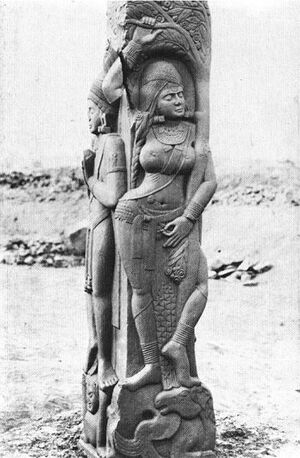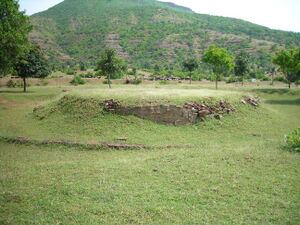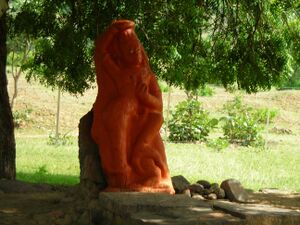Bhar
| Author:Laxman Burdak, IFS (R) |

Bhar (भड़) Bhar (भर) [1] Bhargote (भरगोते)[2] [3] Bharashiva (भारशिव)/Bharshiv (भारशिव)[4] [5] Bhar (भार)[6] [7] is gotra of Jats. Bhar gotra of Jats are found in Rajasthan, Haryana, Punjab and Uttar Pradesh. [8]. Bhar clan is found in Afghanistan.[9] Bhar (भार), a Jat clan is found in Multan,Pakistan.[10]
Origin
Bhar, Bhargote and Bharashiva Gotras originated from Bhar Nagavanshi Kings of the period of Mahabharata.
Branches of Nagavansha are - 1. Vasati/Bains 2. Taxak 3. Aulak 4. Kalkal 5. Kala/ Kalidhaman/ Kalkhande 6. Meetha 7. Bharshiv 8. Bharaich[11]
The ancient place of historical importance of Buddhist period, Bharhut gets the name after its rulers of clan Bhar. [12] They are also called Bharashiva. This gotra started from their ancestral people of Nagavansh who started the new system of worship of Shiva with sivalinga carrying on shoulders. This fact is derived from an Inscription of Bharashiva people found at Balaghat mentioned in Epigraphia Indica Vol.I. [13][14] [15]
'Bhar (भर)' in Rajasthani language is name of a long and high radiating sand dune found in desert which are formed due to piling up of shifting sands.[16] Probably these used to be the habitations of Bhar people in ancient times.
Villages founded by Bhar clan
- Bhar-Bhukti: ('the country of Bhars'. Bharbhukti later changed to Bharhut)[17]
- Bahraich: According to some other historians in the middle age this place was the capital of Bhardynasty. Therefore it was called as “Bharaich”. Which later come to be known as “Bahraich”.[18]
- Bharon Ka Tala (भारों का तला)- village in Chohtan Tahsil of Barmer district in Rajasthan.
- Jasnaul (जसनौल) was the name Barabanki district of Uttar Pradesh before the Muslim conquest. Jasnaul was founded by chieftain named Jas of Bhar tribe during 10th century. Later it was renamed Barabanki after Muslim conquest.
Jat Gotras Namesake
- Bhar (भर) (Jat clan) → Bhardagarh (भरदागढ़). Bhardagarh (भरदागढ़) village is in Jamai tahsil in Chhindwara district of Madhya Pradesh.
- Bhar (भर) (Jat clan) → Bhardi (भरड़ी). Bhardi (भरड़ी) village is in Jamai tahsil in Chhindwara district of Madhya Pradesh.
- Bhar (भर) (Jat clan) → Bharveli village in Bharveli tahsil, Chhindwara, Madhya Pradesh.
- Bhar (भर) (Jat clan) → Bharpayali is a village in Sawali tahsil in Chandrapur district in Maharashtra.
- Bhar (भर) (जाट गोत्र - भर) : भर नाम का गाँव झारखंड के पश्चिमी सिंहभूम जिले की सोनुआ विकास-खंड में है।
Bharia people
Bharia is one of Dravidian-speaking tribes of Madhya Pradesh in India. The Bharias live in Patalkot, which is completely isolated valley some 400 metres below Tamia in Chhindwara district of Madhya Pradesh. This valley is the source of Dudhi River. Patalkot is totally inaccessible by road and one enters along a footpath only. But recently The Madhya Pradesh government established good road inside the Patalkot valley.
There are hundreds of medicinal plant species in the Patalkot valley, and the Bharias have a deep knowledge of the herbs and medicinal plants growing within their valley. Herbal healers from Bharia community are known as Bhagats.
Inscriptions about Bharashiva people: We get mention of rule of Bharashiva people in following Inscriptions:
- Chammak Plates of the Maharaja Pravarasena II 18th year of reign
- Siwani Copper Plate Inscription of the Maharaja Pravarasena II in 18th year of reign
- Tirodi Copper Plate Inscription of the Maharaja Pravarasena II 23rd year of reign
Bharshiv (भारशिव) is a Jat clan. It is a matter of research if Bharshiv (भारशिव) people have any connection with Bharia people of Patalkot.
Mention by Panini
Bhara (भार) is mentioned by Panini in Ashtadhyayi. [19]
धूतपाप
विजयेन्द्र कुमार माथुर[20] ने लेख किया है ...धूतपाप (AS, p.467) अथवा 'धोपाप' सुल्तानपुर ज़िला, वाराणसी, उत्तर प्रदेश में स्थित है। यह एक प्राचीन हिन्दू तीर्थ स्थान है, जो धूतपापा नदी (गोमती की उपनदी) के तट पर स्थित है। कभी यहाँ 'कुशभावन' या सुल्तानपुर के भार नरेशों का राज्य हुआ करता था। इस स्थान का संबंध श्रीरामचंद्र के रावण वध का प्रायश्चित करने से जोड़ा जाता है। यहाँ का क़िला शेरगढ़ नदी के तट पर बना हुआ है।
बाराबंकी का इतिहास
विजयेन्द्र कुमार माथुर[21] ने लेख किया है ...बाराबंकी (AS, p.622) उत्तर प्रदेश राज्य में स्थित प्रमुख शहर है। सिद्धौर तथा कुंतेश्वर के प्राचीन मंदिरों के लिए बाराबंकी ज़िला उल्लेखनीय है। इस स्थान का प्राचीन नाम 'जसनौल' कहा जाता है। इसे 10वीं शती में 'जस' नामक भर राजा ने बसाया था।
भर या भारशिव
भर या भारशिव लोगों के इतिहास की खोज करने का प्रयास किया तो पता चलता है कि ये प्राचीन नागवंशी मूल के राजा थे जो वर्तमान में जाटों के एक गोत्र के रूप में राजस्थान, हरयाणा, पंजाब और उत्तर प्रदेश में मिलते हैं। यह गोत्र अफ़ग़ानिस्तान और मुल्तान (पाकिस्तान) में भी मिलते हैं। इनके प्राचीन इतिहास पर अनुसंधान की आवश्यकता है। दलीप सिंह अहलावत (जाट वीरों का इतिहास, पृष्ठ.241-242) ने इनके इतिहास पर थोड़ासा प्रकाश निम्नानुसार डाला है- कुषाणशक्ति के अस्त और गुप्तों के उदय से पूर्व नागशक्ति शैव धर्मानुयायी रूप से पुनः उदित हुई। इस समय ये लोग शिवजी का अलंकार नाग (सांप) अपने गले में लिपटाकर रखने लगे थे। इन नवोदित नागवंशियों ने शिवलिंग को स्कन्ध पर धारण कर शिवपूजा की एक नई परम्परा स्थापित की थी। अतः इनका नाम भारशिव प्रसिद्ध हो गया। इस नाम को स्पष्ट करनेवाला एक लेख बालाघाट में मिला है। इसका उल्लेख ‘एपिग्राफिका इण्डिया’ भाग 1 पृष्ठ 269 तथा ‘फ्लीट गुप्त इन्स्क्रिप्शन्स’ 245 में इस प्रकार किया है - “शिवलिंग का भार ढोने से जिन्होंने शिव को भलीभांति सन्तुष्ट कर लिया था, जिन्होंने अपने पराक्रम से प्राप्त की हुई भागीरथी गंगा के पवित्र जल से राज्याभिषेक कराया और जिन्होंने दश अश्वमेध यज्ञ करके अवभृथ स्नान किया था, इस प्रकार उन भारशिव महाराजाओं का राजवंश प्रारम्भ हुआ।”
भर या भारशिव लोगों के इतिहास की अधिक जानकारी के लिए मध्य प्रदेश के सतना जिले में स्थित में प्राचीन बौद्ध स्तूप के लिए विख्यात भरहुत नामक स्थान से प्राप्त अभिलेखों का गहन परीक्षण किया जाना चाहिए। भरहुत, सतना जिला,(AS, p.666): मध्य प्रदेश के बुन्देलखण्ड के भूतपूर्व नागोद रियासत में स्थित एक ऐतिहासिक स्थान है। भरहुत द्वितीय- प्रथम शताब्दी ईसा पूर्व में निर्मित बौद्ध स्तूप तथा तोरणों के लिए साँची के समान ही प्रसिद्ध है। स्तूप के पूर्व में स्थित तोरण के स्तंभ पर उत्कीर्ण लेख से ज्ञात होता है कि इसका निर्माण 'बाछीपुत धनभूति' ने करवाया था जो गोतीपुत अगरजु का पुत्र और राजा गागीपुत विसदेव का प्रपौत्र था. इस अभिलेख की लिपि से यह विदित होता है कि यह स्तूप शुंगकालीन (प्रथम-द्वितीय शती पूर्व) है और अब इसके केवल अवशेष ही विद्यमान हैं। यह 68 फुट व्यास का बना था। इसके चारों ओर सात फुट ऊँची परिवेष्टनी (चहार दीवारी) का निर्माण किया गया था, जिसमें चार तोरण-द्वार थे। परिवेष्टनी तथा तोरण-द्वारों पर यक्ष-यक्षिणी तथा अन्यान्य अर्द्ध देवी-देवताओं की मूर्तियाँ तथा जातक कथाएँ तक्षित हैं। जातक कथाएँ इतने विस्तार से अंकित हैं कि उनके वर्ण्य-विषय को समझने में कोई कठिनाई नहीं होती। भरहुत और साँची के तोरणों की मूर्तिकारी तथा कला में बहुत साम्यता है। इसका कारण इनका निर्माण काल और विषयों का एक होना है। इसके तोरणों के केवल कुछ ही कलापट्ट कलकता के संग्रहालय में सुरक्षित हैं किन्तु ये भरहुत की कला के सरल सौंदर्य के परिचय के लिए पर्याप्त हैं।
हरदोई का इतिहास
सैय्यद सालार मसूद ने पहला आक्रमण ईस्वी सन 1028 ईस्वी में बावन पर किया था जो हरदोई से 10 किमी पश्चिम में स्थित है। परन्तु इम्पीरियल गजेटियर का मानना है कि 1217 से पहले स्थाई मुस्लिम कब्जा इस क्षेत्र पर नहीं हो पाया था। अवध के गजेटियर के पेज 55 पर बताया गया है कि 1028 ईस्वी में सैयद सल्लर ने बावन पर कब्जा कर लिया। इसी के आस पास गोपामऊ को भी जीत लिया गया। शेखों के मुताबिक़ 1013 ईस्वी में बिलग्राम को जीत लिया। इसके बावजूद 1217 ईसवी तक नियमित रूप से मुस्लिम नियन्त्रण न हो सका। सैय्य्द शाकिर ने सबसे पहली जीत गोपामऊ पर हासिल की। हुसैनी सैय्य्दों के पूर्वज इराक के वसित शहर से 13 वीं सदी में सुलतान इल्तुतमिश के काल में भारत आए थे। 1217-18 में सैय्यद परिवार ने यहाँ के भर शासकों को हराकर बिलग्राम पर कब्जा किया और यहाँ बस गए। 1540 ई. में बिलग्राम युद्ध शेरशाह ने हुमायूँ को बिलग्राम और सांडी के बीच हराया था और वह एक बिस्ती की सहायता से गंगा पार करके बचपाया था.
History
Sabha Parva, Mahabharata/Book II Chapter 48 mentions in shloka 9 about Bhar clan as under: The tribute were presented unto Yudhishthira by the kings of the earth. And, O king, having brought with them as tribute loads upon loads of sandal and aloe as also black aloe, and heaps upon heaps of valuable skins and gold and perfumes, and ten thousand serving-girls of their own race, and many beautiful animals and birds of remote countries, and much gold of great splendour procured from mountains, the Kiratas waited at the gate, being refused permission to enter.
- चन्दनागुरुकाष्ठानां भारान कालीयकस्य च
- चर्म रत्नसुवर्णानां गन्धानां चैव राशयः (Mahabharata II.48.9)
Bharhut


Bharhut (भरहुत) or Barhut (बरहुत), is a location in Madhya Pradesh, Central India, known for its famous Buddhist stupa. The Bharhut stupa may have been established by the Maurya king Ashoka in the 3rd century BCE, but many works of art were apparently added during the Sunga period, with many friezes from the 2nd century BCE. An epigraph on the gateway mention its erection "during the supremacy of the Sungas"[22] by Vatsiputra Dhanabhuti[23].
The place gets name Bharhut after its rulers of clan Bhar or Rajbhar. It became Bharhut over a period of time.[24] Bharhut was located on route from Kosambi, the capital of Vatsa Janapada to Vidisha, the capital of Dasharna janapada.[25] On this very route is situated another important ancient Buddhist stupa of Deur Kothar discovered very recently, which is 140 kms away from Bharhut in northeast direction in Rewa district. The origin of the word 'Bharhut' would have been from 'Bhar-Bhukti', which means 'the country of Bhars'. Bharbhukti later changed to Bharhut. [26] Bhar is the gotra of Jats found in Districtt Hisar in Haryana. They are also in Punjab who were originally from Rajasthan. Similarly Bharshiv, derived from Bhar, is also a Jat gotra originated from Nagavansh[27]
T.W. Rhys Davids writes that Bharhat and Bharhut both names are correct but Bharhat is more correct. He has mentioned both the names in his book. [28] He writes that plate 13 of Bharhut stupa depicts Raja Prasenjita 600 BCE on a chariot with 24 spiked Dhamma Chakra of Buddha. [29] This shows that Raja Prasenjit was not only the follower of Buddhism but had also adopted Buddha's Dhamma Chakra as state symbol. [30]
James Tod[31] places Bhar in the list of Aboriginal Races, many names in which are not capable of identification, and their correct form is uncertain and those of the mercantile tribes are largely groups confined to Rajasthan.
Distribution in Pakistan
Bhar (भार) are found in Multan area in Pakistan. [32],[33]
Distribution in Haryana
In India they are found in Haryana and in Rajasthan.
Villages in Hisar district
Village Singhwa Khas,
Distribution in Rajasthan
Villages in Tonk district
Raghunathpura Parli (रघुनाथपुरा पारली) village in Malpura tahsil in Tonk district in Rajasthan has population of Bhar Jats.
Villages in Barmer district
Villages in Nagaur district
Notable Persons
References
- ↑ History and study of the Jats/Chapter 10
- ↑ Jat History Dalip Singh Ahlawat/Parishisht-I, s.n. भ-44
- ↑ O.S.Tugania:Jat Samuday ke Pramukh Adhar Bindu, p.53, s.n. 1842
- ↑ Jat History Dalip Singh Ahlawat/Parishisht-I, s.n. भ-55
- ↑ O.S.Tugania:Jat Samuday ke Pramukh Adhar Bindu, p.54, s.n. 1894
- ↑ Jat History Dalip Singh Ahlawat/Parishisht-I, s.n. भ-41
- ↑ O.S.Tugania:Jat Samuday ke Pramukh Adhar Bindu, p.54, s.n. 1888
- ↑ Jat History Thakur Deshraj/Chapter VIII,s.n. 64,p-585
- ↑ An Inquiry Into the Ethnography of Afghanistan, H. W. Bellew, p.126
- ↑ A glossary of the Tribes and Castes of the Punjab and North-West Frontier Province By H.A. Rose Vol II/B , p.84
- ↑ Jat History Dalip Singh Ahlawat/Chapter III,p.242
- ↑ Prof. Suddyumn Acharya, Bharhut Stoopa Gatha (Hindi), Ed. Ramnarayan Singh Rana, Satna, 2007, p. 41
- ↑ Epigraphia Indica Vol.I, p.269
- ↑ Jat History Dalip Singh Ahlawat/Chapter III ,p.242
- ↑ Mahendra Singh Arya et al.: Ādhunik Jat Itihas, Agra 1998, p. 272
- ↑ http://www.jatland.com/home/Glossary_of_Rajasthani_Language/B
- ↑ Dr Naval Viyogi: Nagas the Ancient Rulers of India, 2002, p.332
- ↑ https://bahraich.nic.in/history/
- ↑ V. S. Agrawala: India as Known to Panini, 1953, p.254
- ↑ Aitihasik Sthanavali by Vijayendra Kumar Mathur, p.467
- ↑ Aitihasik Sthanavali by Vijayendra Kumar Mathur, p.622
- ↑ John Marshall, "An Historical and Artistic Description of Sanchi", from A Guide to Sanchi, citing p. 11. Calcutta: Superintendent, Government Printing (1918). Pp. 7-29 on line, Project South Asia.
- ↑ [1]
- ↑ Prof. Suddyumn Acharya, Bharhut Stoopa Gatha (Hindi), Ed. Ramnarayan Singh Rana, Satna, 2007, p. 41
- ↑ M.L. Chadhar, Bharhut Stoopa Gatha (Hindi), Ed. Ramnarayan Singh Rana, Satna, 2007, p. 65
- ↑ Dr Naval Viyogi: Nagas the Ancient Rulers of India, 2002, p.332
- ↑ Mahendra Singh Arya et al.: Ādhunik Jat Itihas, Agra 1998, p. 272
- ↑ T.W. Rhys Davids, The Buddhist India, 1971, p. 209
- ↑ T.W. Rhys Davids, The Buddhist India, 1971, p. 91
- ↑ Dr C.D. Naik, Bharhut Stoopa Gatha (Hindi), Ed. Ramnarayan Singh Rana, Satna, 2007, p. 25
- ↑ James Todd Annals/Chapter 7 Catalogue of the Thirty Six Royal Races,p.144
- ↑ Jats the Ancient Rulers (A clan study), Bhim Singh Dahiya, p. 333
- ↑ Rose:'Tribes and Castes', Vol. II, p. 84
Back to Jat Gotras

